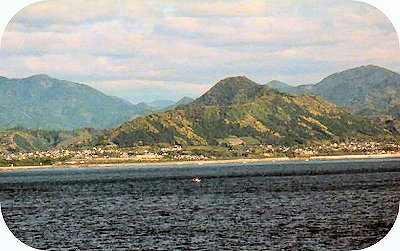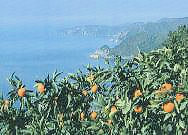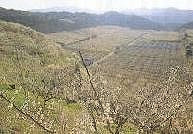|
 |
|
|
|
|
 |
| Kumanonada Sea and Kii Mountains |
|
| 2. Outline of Nanki-Kumano |
|
|
"The Road of Fire"
I read through "The Road of Fire" by Seicho Matsumoto in 1991.
The main theme of this book was the inquiry into the relationship between
the ancient Japan and the Percian culture, pinpointing the ruins around
Asuka District, Nara Prefecture, as a core.
The characters proceeding the story were somehow interesting respectively
all right, but the main subject, the riddle of the artificial stone, was
honestly a burden to me, though the writer Matsumoto put his particular
emphasis on it.
Sorry to get sidetracked, the name "Kumanoji" sometimes appeared in the story. It is what we now call "Kumano-kodo" (Kumano Ancient Roads).
This "Kumanoji" strangely let me feel nostalgic, helped by the
writer's clever description. That is because it made me think of the Nank-Kumano District and my hometown
Miwasaki in the area.
Kumanoji, or Kumano Ancient Roads, consists of the several ancient pilgrimage
roads from Kyoto and Nara to the south.
One of the Roads comes down the mountains to the south via Hongu Grand Shrine and Hayatama Grand Shrine. At last it reaches the seashore of the Pacific Ocean.
The shore faces "Kumanonada" or Kumano Open Sea, and Miwasaki,
a small fishing town, looks out on the shore.
Now in Miwasaki live my younger brother's couple and my mother aged 82.
When I read through "The Road of Fire," I called up to my mother,
Kumano.
Her voice was in the local dialect.
 "Glad to hear, Shigeru." Shigeru is my name. "Glad to hear, Shigeru." Shigeru is my name.
"Are you all right, grandma? I suppose you are very well, aren't you?"
"I am fine, thank you. I am walking wheeling a pram everyday, around
Kuroshio Park at the beach, the grave of grandpa, etc." Granpa is
her husband, Shigezo.
"It is nice, isn't it?"
"Granpa is always with me. I am happy to meet him there. He is always
protecting me, always with me."
|
|
Access to Nanki-Kumano
Nanki is the southern part of Wakayama Pref., approximately the area south
from Tanabe City.
While there are various opinions about what and where Kumano is. In my
idea, it is, in addition to Nanki District, west of Owase City, Mie Pref.,
and also includes the Nara side of Doro Gorge.
I am talking about the district of Nanki-Kumano.
It is my pride that I was born in Nanki-Kumano.
How I wish many more people come to know much more about Nanki-Kumano.
The more they know this area the more they will feel how wonderful Nank-Kumano
is. They will even say, "We won't go back."
|
|
|
Everybody will be enslaved by Nanki-Kumano !
 As mentioned above, Nanki-Kumano is the south of Kii Peninsula, surrounded by Wakayama Pref., a part of Mie and Nara Pref. As mentioned above, Nanki-Kumano is the south of Kii Peninsula, surrounded by Wakayama Pref., a part of Mie and Nara Pref.
The attractive features of Nanki-Kumano are hot spring villages, a mild
climate brought by the Kuroshio Current, brightness peculiar to the southern
region, and a lot of places of natural beauty and historic interest as
well as shrines and temples.
In midsummer, sprays from the waves along the coast dashed up against the
deep blue sea fly so dazzlingly in disorder.
There are several routes to Nanki-Kumano. Each of them is not so convenient. (as of 2014)
1
|
From Nagoya, trains of the Kisei Main Line along the coast, or cars on
the road National Route 42. (The road from Nagoya has become very convenient.
The speedway was constructed until Kumano City near Shingu, as of 2014,
courtesy of Shingu City.) |
2
|
From Osaka, trains of the Kisei Main Line along the coast, or cars on the
road National Route 42. (The road from Osaka has become convenient. The
speedway was constructed until Tanabe City. Then it is better to ride on
the National road 311 to Shingu City, as of 2014, courtesy of Shingu City.) |
3
|
From Tokyo, Shinkansen or Bullet Line until Nagoya, and then the Kisei
Main Line along the coast. |
4
|
From Nara, roads along Totsukawa River and then Kumano River to Shingu. |
5
|
There is no route by the sea. But before I enjoyed this route very much.
My impression during those days is like the following.
(The ocean liner "Sunflower" between Tokyo and Nanki-Kumano.
Get on the liner at Ariake Wharf in Tokyo at 8:00 pm and get it off at
Katsuura Port at 8:00 am. It is a nice cruising along the shores of Pacific
Ocean. Early in the morning, the scenery of the Kii Peninsula from the
deck is just wonderful.) |
6
|
By plane, there is a service between Haneda and Kii-Shirahama. It takes
one hour and a half. I have no experience. |
|
|
|
| Season
All the year is the tourist season in Nanki-Kumano. Some people advise
to avoid the period of the rainy season in June and that of typhoon from
latter August to September all right. However, I would not exclude any
season if you like, because they are also unique to Nanki-Kumano.
Flowers come out in the beginning of March, then we welcome spring.
Fresh green leaves are dazzling in April. You can enjoy sea bathing from the middle of June to early September. Crinums or hamayu are in bloom around the seashore.
In October, after typhoon season, the weather is mostly fine and clear,
and autumn leaves are in full bloom.
Taste
Nanki-Kumano is a treasure house of fresh marine products. Moreover, you
can taste unique sushi like mebarizushi, narezushi, sanmazushi, etc. (Sanmazushi
is my favorite of all.)
As these kinds of sushi are with rice including vinegar, they can be well preserved in the warm climate.
There are few local specialties even though this area is surrounded by
the sea on three sides. Just as you expect, its charm of dishes is the
natural taste of seafood like fresh slices of raw fish.
Nanki-Kumano is a mikan district. Mikan is a kind of mandarin oranges.
They are generically called Unshu mikan, and are widely cultivated from
Wakayama City to around Owase City, Mie Pref., and of all, Arita mikan
and Mihama mikan are famous.
In addition to Unshu mikan, Sanbo mikan, Summer mikan, Valencia mikan and others are produced in these areas.
In my hometown Miwasaki, an Unshu mikan was called "ko-mikan"
(a small mikan), and a Summer mikan simply a mikan. A Summer mikan is large
and sour.
Nanki-Kumano is also famous for the production area of ume, a Japanese
apricot. Especially Shirahama, just north of Tanabe City, and the town
of Minabe are the area of Nanko-ume, which is connected with the name of
Minabe High School. A certain teacher of the school developed it. Its seed
is small, and fruit is thick.
|
|

mikan |

ume |
|
|
In April 1998, when I travelled on a sightseeing bus from Shingu to Kansai airport in Osaka along the coast of the Pacific Ocean, the lady guide sang the following song "The Life of Ume" on the way around Minabe. |
|
We are already in full bloom
in January and February.
Pleasant spring days,
bush warblers' singing...,
are gone in a dream.
When we bear fruits in May and June,
shaken off from branches,
carried out to neighboring towns,
sold by weight.
Our bodies, originally sour,
get salty by salt and red by shiso.
During hot July and August,
summer airing of whole three days.
Our life is nothing but pain.
We are young at heart
and join you, small friends
in spite of the wrinkles of age and care.
We must be inevitable much more so,
when a battle happens. |
|
|
| Part 2 Reading 13' 20" |
|
|
|
|
|
|
|
|
|